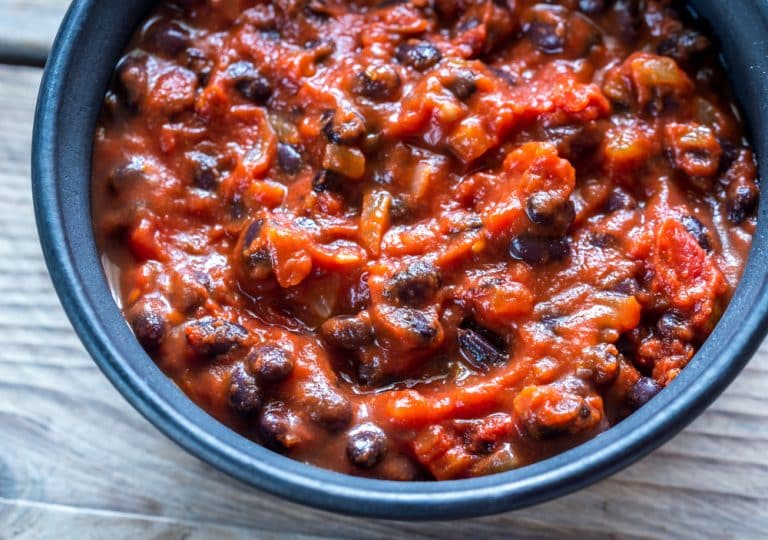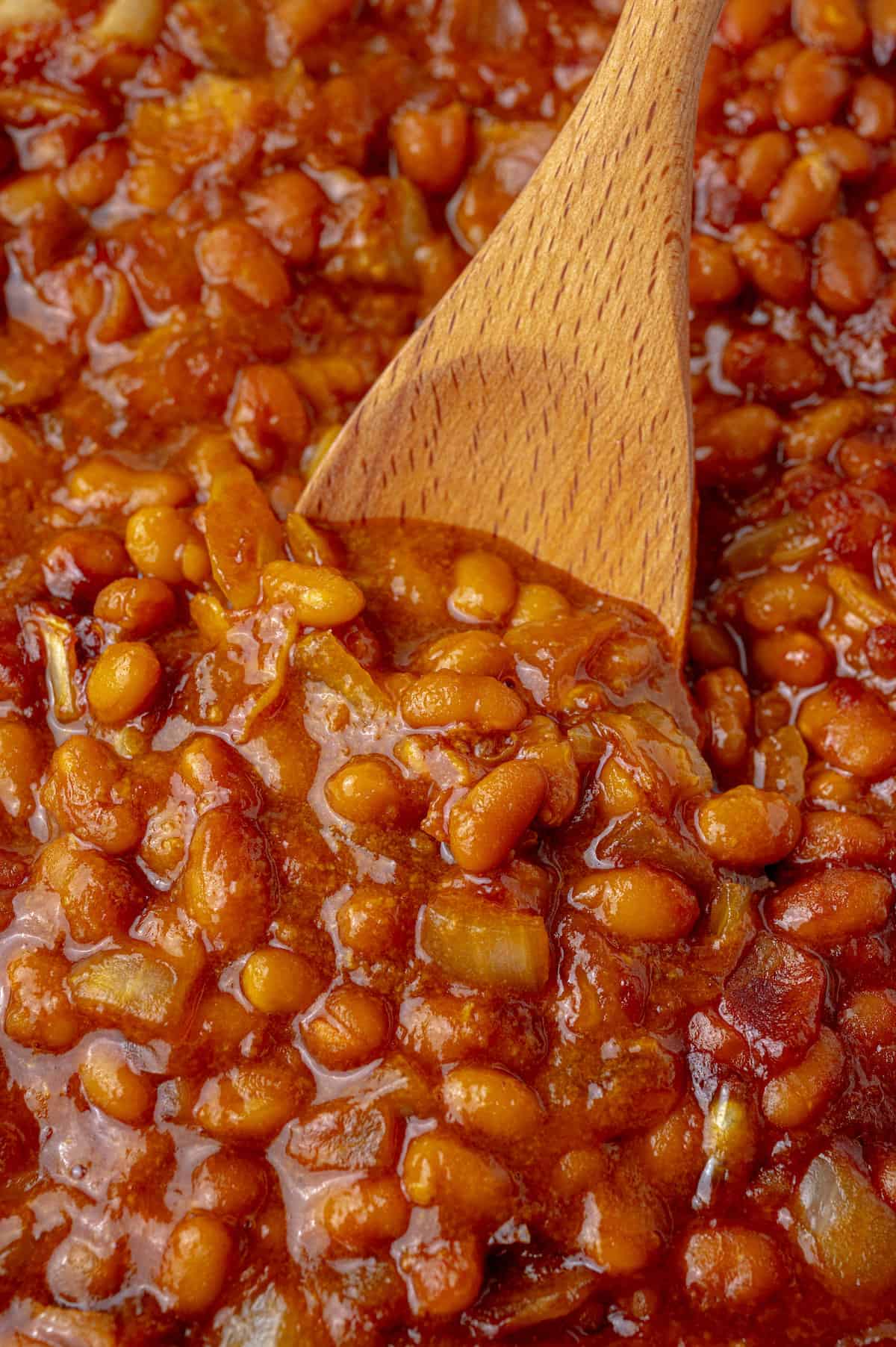Need a quick and easy baked bean recipe that the whole family will love? This old-fashioned pork and beans recipe is easy to make and takes canned pork and beans to the next level.
Baked beans are a classic American potluck staple With a sweet, tangy and smoky flavor profile, they are the perfect side for backyard barbecues and summer picnics While recipes vary, most start with a base of canned pork and beans. But when opening that familiar blue and white can, an important question arises – should you drain and rinse the beans first or just use them as is?
Before you decide whether to drain canned pork and beans for baked beans, you should think about the pros and cons. This article will talk about the main things that will help you figure out the best way to get the texture and taste you want.
The Case for Draining Beans
Here are some reasons you may want to drain and rinse canned pork and beans before baking
-
Less salt: Draining gets rid of some of the salty liquid, which helps lower sodium intake.
-
Limits Messiness – Draining the thick bean juice reduces mess if beans bubble over while baking
-
Removes Excess Liquid – Draining prevents beans from being too watery, runny or oily.
-
Allows Seasoning Control—Because there is less liquid, you can use seasonings to better control the taste instead of just tasting pork and bean juice.
-
Prevents Soggy Beans – Beans retain shape better after draining instead of steaming in can liquid.
So if watching your salt intake, avoiding spills, or achieving the ideal bean texture are priorities, draining pork and beans is likely the way to go.
Reasons to Skip Draining Beans
On the other hand, here are some potential advantages to baking beans undrained straight from the can:
-
Saves Time and Dishes – No need to dirty and wash a strainer or colander. Opening and dumping is fast and simple.
-
Retains Nutrients – Draining can wash away some B vitamins and minerals canned in the bean liquid.
-
Adds Moisture – The viscous juice keeps beans tender and moist while baking in the oven.
-
Boosts Flavor – Many seasonings are already added to the canning liquid, offering robust pork and bean flavor.
-
Thickens Sauce – Starchy bean liquid helps create a rich, thick baked bean sauce.
So if you want fast and fuss-free prep with maximum nutrition and flavor, baking beans undrained may be preferable.
How to Decide: Key Factors
With good reasons on both sides of the debate, how do you choose whether or not to drain canned pork and beans? Here are some key factors to consider:
-
Bean Variety – White beans like navy and great northern hold shape better when drained compared to soft bean types that need more liquid.
-
Additional Liquids – Account for other wet ingredients like ketchup, mustard, molasses, etc. that make draining less necessary.
-
Cooking Method – Beans baked uncovered in the oven benefit more from draining than slow cooked beans retaining moisture.
-
Final Consistency – Drain beans if desiring a thick, scoopable baked bean consistency versus a saucy, soupier texture.
-
Flavor Intensity – Draining reduces the strong canned pork and bean taste, allowing other seasonings to shine.
-
Sodium Content – To limit sodium, draining and rinsing beans helps remove some saltiness.
So factor in your recipe, preferences and health goals to decide whether to embrace the bean juices or drain them away.
How to Drain and Rinse Canned Pork and Beans
If opting to drain and rinse, here is a quick guide:
-
Open can and pour entire contents into a mesh strainer or colander in the sink.
-
Let liquid drain completely, at least 1-2 minutes. Shake strainer gently to remove all juice.
-
Optional: Rinse beans briefly with cool water to further reduce sodium, starch and enhance flavor.
-
Shake strainer well to drain off all rinse water. Beans should not be wet or dripping.
-
Transfer drained beans to your baking dish and proceed with recipe as directed.
Tip: Save the drained bean liquid to use as a vegetarian broth base for soups or gravies. The starchy juice lends great flavor and texture.
Prepping Pork and Beans for the Best Baked Beans
While the draining debate continues, here are some other tips for handling canned beans:
-
Inspect beans and discard any discolored or damaged beans.
-
If time allows, rinse and sort dried beans from scratch for ultimate taste and texture.
-
Swap out salt pork or bacon grease for healthier fats like olive oil if concerned about sodium.
-
Mix in extra vegetables like chopped onions, carrots or bell peppers for added nutrition.
-
Season with spices like mustard, garlic, pepper and chili powder to boost flavor.
-
Finish with garnishes like chopped scallions, grated cheese or sliced jalapeños for a flavor and texture pop.
So go with your gut and drain or not drain those canned pork and beans depending on your specific recipe and preferences. Because whether you embrace the starchy bean juices or pour them out, you still can’t go wrong with the classic flavor of homemade baked beans!

To make baked beans in the crockpot
You can make the entire recipe in the slow cooker. I like to cook the bacon ahead of time in a skillet.
If the beans look too thin, take the lid off of the crock pot with baked beans about 30 minutes before serving to thicken them. This allows some of the liquid to evaporate.
You can find instructions to make the baked beans slow cooker recipe below!
How to make Baked Beans with pork and beans
We’re combining all our ingredients in one of two vessels. If you’re baking these in the oven, you’ll need a casserole dish.

- Step 1: Okay, we’re going to use a big can of beans and spice it up with some seasonings and spices. Bacon, of course. You can add more bacon if you want, but my recipe only calls for two slices. In the pan go chopped onion, yellow mustard that has been made, molasses, brown sugar, and Worcestershire sauce.

- Step 2: Put foil over it and bake it for 90 minutes.
The recipe is super easy, right? I promise it’s easier to make than it is to pronounce Worcestershire.

Pork and Beans Recipe – Easily Turn Canned Beans into AMAZING
FAQ
Do you drain baked bean juice?
Do you have to drain Bush’s baked beans?
Is it okay to use the liquid in canned beans?
Should I drain canned beans?
Can you use canned pork and beans for baked beans?
In this case, Grandma relied on canned pork and beans for her easy baked beans recipe. It isn’t cheating to use canned beans when you have hungry mouths to feed! I personally like the Van Kamps pork and beans. The beans have a nice texture, and the pork is not too salty. You can also find them in larger family serving style cans.
Can you cook pork N Beans in a slow cooker?
Canned pork ‘n beans sweetened with brown sugar and filled with pieces of thick bacon. Made on your stovetop or in your slow cooker, it’s the perfect side dish for any time of the year! I always loved it when my Grandma Czaplewski made her baked beans for get-togethers. Something about them just always tasted better than anyone else’s.
Can you cook baked beans with canned beans?
Making this baked beans recipe with canned beans cuts out hours of cook time. I usually opt for low sodium great northern for baked beans because they have a creamy texture and are mild so the BBQ flavors can shine. Bonus: beans are low in fat, high in protein and just 1/2 cup provides more than 20% of the daily recommended amount of fiber.
How long do you cook canned pork & beans?
Canned pork and beans make meal prep quick. —Phyllis Schmalz, Kansas City, Kansas Preheat oven to 325°. In a large bowl, mix all ingredients. Transfer to a greased 3-qt. baking dish. Bake, uncovered, 1-1/4 to 1-1/2 hours or until bubbly.
